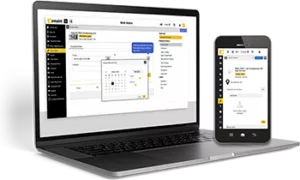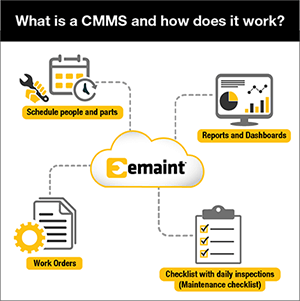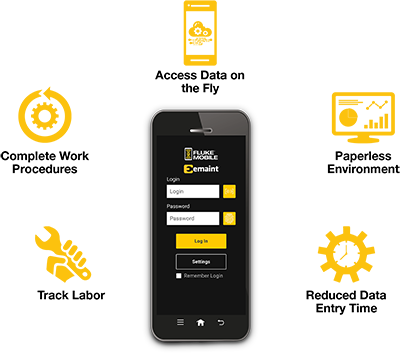What is CMMS Software?
A CMMS, or Computerized Maintenance Management System, is a software solution designed to streamline maintenance processes and improve asset management within an organization. It enables maintenance managers to schedule, track, and analyze work orders, inventory, and maintenance tasks efficiently. By utilizing a CMMS, organizations can reduce downtime, extend asset life, optimize labor resources, and enhance overall maintenance operations.
A CMMS serves as a command center for maintenance and reliability programs. It’s also a centralized database for storing key data. Maintenance teams use CMMS software to track their work and gain insight into machine health and reliability, making it ideal for managing industrial facilities where machine assets are critical to production.
CMMS software optimizes the use, availability, and life span of equipment, machinery, fleets, infrastructures, facilities, or operations.
Today’s CMMS solutions are cloud-based and offer innovative features like a mobile CMMS app, regulatory compliance tools, and multi-site or multilingual capabilities. They can also integrate with apps like ERP purchasing software, or tap into siloed production data from SCADA, PLC, and BMS systems. Leading CMMS platforms can even connect with condition monitoring sensors and software, giving teams the power of predictive maintenance.
CMMS system, solution, platform, and software are all synonymous terms – they all refer to digital systems for maintenance management.
Organizations can harness the power of CMMS software to save time, simplify their work, prevent downtime, reduce maintenance costs, and strengthen the reliability of their assets.
Computerized
Nowadays, everything is on computers. It was only a matter of time until the clipboard and pen of yesteryear were discarded for modern technologies. The best CMMS software providers will help you integrate your previous hard-copy, paper trail into the computerized interface. This way, no data is lost when migrating to a computerized maintenance management software solution.
Maintenance
No computer available has the function and capacity to complete maintenance as quickly, efficiently, and precisely as skilled labor. Performing preventive maintenance, or routine inspections, or ensuring a work order is completed is still a job for maintenance teams. Instead, a CMMS helps teams schedule work orders, gauge parts and supplies inventories, and use data to make maintenance decisions.
Management
A CMMS helps front-line workers execute work orders. But it helps management plan, schedule, and report on work being done. It allows leadership to create forecasts as well as report back on completions, compliance, audits, or other maintenance KPIs.
System
Computerized maintenance management system software can’t replace workers. However, it can augment their current practices and improve the efficiency of labor completion. eMaint CMMS fits in with current maintenance practices and processes, allowing users to customize features to their needs.
Computerized maintenance management system software helps teams manage their day to day. It also helps teams integrate new maintenance solutions, such as condition monitoring.
How does CMMS software work?
Among other things, a CMMS system functions as a work order software to track maintenance orders and schedule tasks. It helps maintenance teams manage their workflows and minimize downtime. Through integrations with vibration sensors and other condition monitoring tools, a CMMS and its database also lets teams keep tabs around-the-clock on machine health and conditions, so they can implement condition-based maintenance.
Other key CMMS integrations, like Enterprise Resource Planning software, can help maintenance teams connect their operations to the purchasing and inventory functions used elsewhere in an organization. While maintenance and reliability teams may spend their time focus on keeping machines running, today’s organizational environments make it must that a CMMS can communicate seamlessly with these other business systems.
Today’s maintenance managers rely on CMMS systems to level up their maintenance programs, streamline processes, and improve tracking and analysis of maintenance KPIs. A CMMS can also enable accurate documentation for maintenance activities, which is vital for heavily regulated industries subject to audits.
In the end, a CMMS is a database, and information within supports a variety of functions across different teams. Those in operations or finance can benefit from visibility into inventory status or costs, supply contracting, and other maintenance functions.
A CMMS can help organizations manage and streamline:
- Resources and labor
- Asset lifecycle
- Work order prioritization and scheduling
- Preventive maintenance
- Materials and inventory
- Audits and compliance tracking
- Reporting and dashboarding
- Mobile maintenance functionality
- Condition monitoring
- Customized training and support
What are the benefits of using a CMMS software?
There are many efficiency and lifecycle benefits from implementing and using computerized maintenance management system software. Overall, it allows teams to align their maintenance practices and activities with other departments and business goals. When you have a system that allows cross-departmental sharing of data, everyone’s job gets a little more efficient.
Some of top benefits of a cmms software include:

Healthy and Safe Environments
In line with global, national, state, or local regulations, a CMMS can improve safety, health, and environmental issues. When assets are properly maintained and in a timely fashion, they’re less likely to have a failure that endangers workers. Get reports on incidents, defects, correction action histories, and process change management.
Workflow Visibility and Work Order Management
Work order software allows teams to visualize actions through dashboards and reports, helping every level of worker assess the current status and improve work order completion rates. Maintenance teams can quickly determine where an asset is, what parts are needed, and who should perform what work and when.
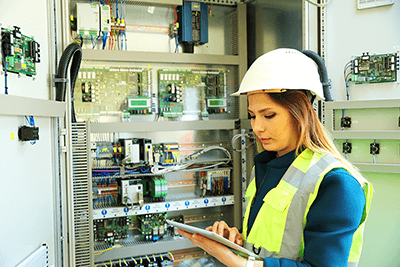

Mobile Workforce
Keeping field workers on the go can be a difficult and pricey endeavor. However, the best software offers advanced mobility connectivity for users who rarely need to come back to the office. Deploy teams remotely using a CMMS that supports mobile workers.
Automation and processes
There are so many process that are prime for automation:
- Inventory reorders
- Scheduling shifts
- Assigning work orders by availability
Transitioning to a CMMS database allows users to automate many processes. Automation saves time, reduces human error, and increases efficiency.
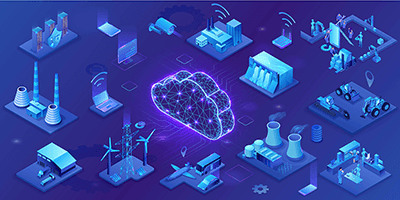
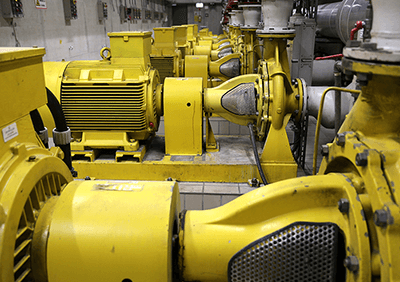
Asset Lifecycle Visibility
CMMS software allows teams to track and manage asset health and lifecycle from pre-installation planning and engineering to decommissioning. When you know what the active status is of your assets, you can better plan, schedule, and perform work.
The Road to Prescriptive Maintenance
Software helps teams move from reactive through preventive and predictive maintenance to a prescriptive maintenance strategy. By integrating data from sensors, usage statistics, and more, maintenance teams gain visibility into asset health. Then, software can make AI-enhanced analytics on what actions to take and when.


Regulatory Compliance and Audits
With compliance regulations from local, regional, state, national and global organizations, it can be hard to keep up with audits. However, a CMMS can ensure regulatory compliance and creates the digital paper trail that most compliance audits look for to determine how well an organization has met all necessary standards. Health and safety, IT, energy and environmental management and quality management standards are a few examples that apply to a range of industries.
Advantages of CMMS Software
A CMMS has numerous advantages for maintenance and reliability teams seeking to save time, improve efficiency, maximize uptime, and strengthen reliability. Integrating a CMMS software doesn’t just digitalize maintenance management—if utilized correctly, a CMMS can help boost core KPIs, cut maintenance costs, and drive production. Going into the age of AI, IIoT, and smart factories, having a CMMS is an essential tool for streamlining and managing your maintenance team.
Here are some of the major advantages that maintenance programs with CMMS software have over the competition:
- Reduce downtime with preventive and predictive maintenance
- Save time on everything from management to organization, scheduling, data entry, and reporting
- Increase overall reliability and extend equipment lifespan with asset management, tracking and analysis
- Ensure business meets regulatory compliance and safety standards with maintenance standardization across teams and worksites
- Boost work order completion rates with work order management
- Track and reduce maintenance costs with purchasing software integration
- Monitor and increase productivity and reduce labor with work order scheduling
- Simplify reporting by tracking KPIs and offering easy-to-use reports and dashboards
Common Features of a CMMS
Modern CMMS software generally has all of the following capabilities:
- Work order management
- Create, assign, and complete work orders and work requests.
- Asset management
- Track assets, see their current status, and view detailed maintenance history.
- Preventive maintenance
- Schedule recurring PMs for assets and include tasks, procedures, and parts. Advanced CMMS platforms also offer interactive drag & drop calendars for simplified PM planning.
- Parts & inventory management
- Book spare parts for work orders and attach them to relevant assets. Monitor inventory levels and receive alerts when parts need to be reordered.
- Reporting & analytics
- Design reports of maintenance activities and build dashboards to gain visibility into key processes and KPIs.
- Mobile CMMS app
- Manage maintenance from the palm of your hand, from work orders to booking parts. Premium CMMS apps allow offline work that syncs later.
- Regulatory compliance
- Easily build audit dashboards to demonstrate compliance. Review and report on records stored in a comprehensive audit trail. Safeguard key actions with electronic signatures.
- Integrations
- Integrate your CMMS with your core business software, from SAP to Power BI, with API connections or through low-code integration. Tap into SCADA & PLC systems to access condition data.
- Predictive maintenance
- Connect to condition monitoring sensors and software to automate work orders based on condition data, evolving your strategy into predictive maintenance
- Multi-site capabilities
- Enterprise-friendly CMMS software gives you the ability to manage multiple sites, standardizing maintenance strategy and allowing for global reports. Multi-site CMMS platforms generally also allow you to work across languages, time zones, and currencies.
What is a Mobile CMMS?
A mobile CMMS is a smartphone app that simplifies maintenance management on the go.
Mobile CMMS apps connect your maintenance team, reduce labor, and contribute to maximizing your asset uptime. Communication is streamlined and your team can work in the field, streamlining your maintenance management.
Fluke Mobile, the eMaint CMMS app allows you to manage work orders, submit work requests via QR code, book spare parts, track work hours, and much more.
A premium mobile CMMS like the Fluke Mobile app gives you a wealth of features:
- Work Offline
- View & Update Work Orders
- Upload Photos / Documents
- Log Work Hours
- Get Data from Fluke Multimeters
- Push Notifications
- Manage Assets & Equipment
- Scan QR Codes on Assets for Info or Submitting Work Requests
- Audit Trail Tracks Your Change
- Much more!
A mobile CMMS, powered by a world-class CMMS like eMaint, breaks down barriers in industrial data and gives your team vital information in the field.
Parts Inventory Management Software
Parts inventory management is essential to running a successful maintenance storeroom. Having the right part, in the right amount, at the right moment, is vital to maintaining your critical assets – and requires strategic planning and inventory management.
Leading CMMS platforms also serve as parts inventory management software, simplifying the tracking of parts across storerooms and allowing you to assign them to maintenance work. You can quickly search through your parts and find what your need
eMaint CMMS is also a parts inventory software, giving you the power to track, assign, and submit purchase requests for spare parts. Parts can be assigned to work orders and PMs, and with eMaint’s audit trail, you can perform historical analysis on part performance in your key assets. eMaint’s reporting tools allows you to easily build reports and dashboards that can give you actionable insights for how you’re managing your storeroom. You can easily find out-of-stock parts in the Parts Reorder List, which gives you quick insight into what critical spares you’re missing.
Walking through your storeroom, a premium parts inventory management CMMS like eMaint also allows you to scan barcodes on your parts to view records instantly on your mobile device.
Choosing the Best CMMS Software Solution for Your Team
Choosing the right CMMS can be a difficult process. An estimated 80% of CMMS implementations fail to meet expectations due to lack of training and support after the sale.
The best CMMS software includes features like managing work orders and parts inventory, automating predictive maintenance activities, enabling proactive maintenance strategies, documenting maintenance activities for compliance, and much more. Solution providers should also provide robust training and support services before, during, and after deployment of software.
Ultimately, the best CMMS for you is one that can be configured to fit your unique requirements now – and grow with you into the future.
4 Key Features to Look For in a CMMS
While there are many critical features that support these objectives, there are four must-haves for the CMMS implementation:
- Configurability: There’s no one way to manage your maintenance operations. Every industry, company, and maintenance team has individualized needs. The best CMMS software is flexible to meet your unique requirements and scale with you over time.
- Training and Professional Services: Find a partner that will provide the support you need both before and after the sale with training, implementation support, and long term professional services to keep your maintenance operations moving in the right direction.
- Ease of Use: For any maintenance software, ease of use is key, especially for a software meant to make your job easier. Navigation and discovering insights should be simple and intuitive.
- Mobile CMMS / Work Order Software App: The best CMMS software has strong mobile CMMS capabilities, including a best-in-class work order software app. Maintenance operations are now driven by real-time, actionable insights, readily available at your team’s fingertips no matter where they are located.
What’s Better: SaaS or On-Prem?
One of the major values in getting Software-as-a-Service is rapid experimentation and deployment. Partner CMMS companies can easily upgrade features without compromising data or current functionality. Conversely, on-premises software solutions require intense collaboration between IT and information security experts to ensure accessibility without data corruption.
What is EAM?
Enterprise Asset Management (EAM) is a strategy for managing company assets throughout their lifecycles by planning operations and maintenance activities. The goal of EAM is to enhance asset performance, expand lifespan, and increase uptime. An EAM program generally synthesizes sensors, software, and tools to gather data; equipped with this valuable knowledge, maintenance and reliability professionals can make maintenance profitable.
EAM programs take advantage of the following practices and more to ensure asset health:
- Asset lifecycle management
- Work order management
- Planning and scheduling
- Reporting and analytics
- Supply chain and inventory optimization
- Safety initiatives
- Financial management
A CMMS is a software command center for your EAM strategy – simplifying tactics like digital work orders, condition monitoring, and preventive maintenance scheduling.
What’s the difference between CMMS, FM, and EAM?
A CMMS software helps maintenance teams optimize their daily maintenance management duties including assigning and completing work requests, performing preventive maintenance tasks and inspection rounds, managing spare parts inventory and labor resources to maximize equipment availability.
Facility Management Software encompasses CMMS functions and also automates additional aspects of facility management including budgeting and capital expense tracking and contract management.
EAM (Enterprise Asset Management) focuses on the entire lifecycle of an asset from design and installation through ongoing maintenance through to retirement or replacement.
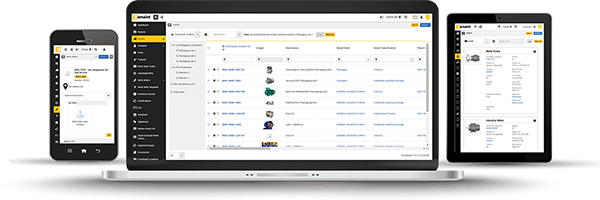
What’s Better: SaaS or On-Prem?
One of the major values in getting Software-as-a-Service is rapid experimentation and deployment. Partner CMMS companies can easily upgrade features without compromising data or current functionality. Conversely, on-premises software solutions require intense collaboration between IT and information security experts to ensure accessibility without data corruption.
CMMS Frequently Asked Questions
eMaint Customer Reviews
“eMaint CMMS was really intuitive. I was able to figure out how to update my forms myself and just rely on eMaint to really double-check everything for us.”
“Now, the auditor comes in, and he says, ‘Show me your last cooling tower PM.’ I go to work orders; I filter on historical, I filter on the contractor who does the cooling towers, I pull up the last one, take him to the linked document, I open it up, he checks a box. Done. Next.”
“I’d definitely say Anaergia plans to implement the new eMaint X5 CMMS software in its upcoming project. Being a global company, acquiring parts from various regions of the world, whether it’s in pounds, euros, dollars, … being able to store the base price and follow that in multiple currencies will be a huge benefit.”
“The first year I was here after I put eMaint in, year-over-year we increased about 14%. The year after that we increased about 6%, and this past year we increased 8%. That’s over 20% in the last three years, and I would say a good portion of that is because we have our maintenance a little bit more in control now.”
“I really like the system. And the capabilities are seen by people and understood to be a benefit. What’s really been a big success for us is getting the information, [getting] what we need to know on how we’re operating.”
“World-class maintenance is what we strive for, and world-class maintenance programs use a CMMS.”

